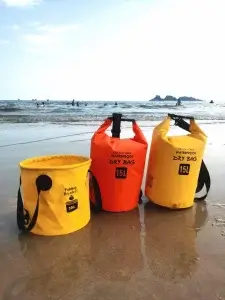Decoding the Best Waterproof Bag Material
- Latest update

Written by Jason
Introduction
 Waterproof bags have become an indispensable accessory for adventurers, travelers, and even everyday individuals who seek to protect their belongings from the unpredictable forces of nature. These bags offer a vital defense against moisture, ensuring that the contents inside remain dry and undamaged even in the harshest conditions. Whether you’re exploring rugged terrains, embarking on water-based activities, or simply navigating through a downpour, having a reliable waterproof bag can make all the difference.
Waterproof bags have become an indispensable accessory for adventurers, travelers, and even everyday individuals who seek to protect their belongings from the unpredictable forces of nature. These bags offer a vital defense against moisture, ensuring that the contents inside remain dry and undamaged even in the harshest conditions. Whether you’re exploring rugged terrains, embarking on water-based activities, or simply navigating through a downpour, having a reliable waterproof bag can make all the difference.
The Importance of Waterproof Bags
The significance of waterproof bags cannot be overstated when it comes to safeguarding your possessions. Imagine trekking along muddy trails during a heavy rainfall or kayaking through turbulent waters with important documents or electronic devices in tow.
Without proper protection, these items would be susceptible to irreparable damage from water seepage or soaking. Waterproof bags provide an impenetrable barrier against moisture and ensure that your valuables remain safe from any potential harm.
An Overview of Different Materials Used in Waterproof Bags
Various materials are utilized in the construction of waterproof bags, each offering distinct advantages and disadvantages. Understanding these materials is essential in making an informed decision when choosing a waterproof bag that suits your needs. Polyvinyl Chloride (PVC), a highly versatile synthetic plastic material renowned for its durability and resistance to water penetration, is commonly used as a waterproof bag material.
PVC possesses excellent waterproof properties due to its inherent ability to resist moisture absorption. However, it may lack breathability and can be less environmentally friendly compared to other alternatives.
Another popular material employed in manufacturing waterproof bags is Thermoplastic Polyurethane (TPU). TPU combines the best qualities of both rubber and plastic, offering exceptional flexibility while maintaining superior resistance against water ingress.
This material is not only highly durable but also more environmentally friendly than PVC. Nylon with a specialized waterproof coating is also widely utilized in the production of waterproof bags.
The base nylon material is known for its strength and abrasion resistance, while the waterproof coating enhances its ability to repel water. Although this combination provides considerable waterproofing capabilities, the durability of the coating may vary based on quality and usage.
Vinyl, although not as waterproof as PVC or TPU, can provide a degree of water resistance. It is often used in bags designed for lighter rainfall or splashes rather than full submersion activities.
Vinyl offers good flexibility and can be more cost-effective compared to other alternatives but may not provide adequate protection in extremely wet conditions. By exploring these different materials used in waterproof bags, you can make an informed decision about which option best suits your specific requirements.
Understanding the pros and cons of each material will ensure that your chosen bag offers optimal protection while aligning with your priorities regarding durability, environmental impact, and budget constraints. When it comes to safeguarding your belongings from moisture-related damage during outdoor adventures or everyday life situations prone to water exposure, investing in a high-quality waterproof bag becomes paramount.
The variety of materials available ensures that there are options suited to every individual’s needs and preferences. By assessing the importance of such bags and familiarizing yourself with different materials utilized in their construction, you can confidently select a reliable companion that will keep your belongings safe and dry throughout any endeavor or weather condition.
PVC (Polyvinyl Chloride)
The Waterproof Wonder
When it comes to waterproof materials, PVC reigns supreme. This versatile thermoplastic polymer boasts exceptional waterproof properties, making it a popular choice for various applications, including waterproof bags.
PVC’s ability to repel water lies in its inherent chemical structure. The tightly bound molecular chains prevent water molecules from permeating through the material, ensuring your belongings stay dry even in the harshest conditions.
Advantages of PVC as a material for waterproof bags are plenty. Firstly, its remarkable durability provides excellent protection against tears and punctures, which is crucial for outdoor adventures.
Additionally, PVC’s resistance to UV damage ensures that the bag remains unaffected by prolonged sun exposure while retaining its vibrant color. Furthermore, this material is relatively low maintenance; it can be easily wiped clean with a damp cloth.
However, like any material, PVC has its drawbacks too. One notable disadvantage is its environmental impact during production and disposal.
The manufacturing process involves the use of toxic chemicals such as chlorine and dioxins that can harm ecosystems if not properly managed. Additionally, PVC is not as flexible or lightweight compared to some other materials used in waterproof bags which might make it less suitable for certain activities where mobility is key.
TPU (Thermoplastic Polyurethane)
Flexibility meets Waterproofing
In recent years, TPU has gained popularity as an alternative to traditional materials like PVC due to its unique combination of flexibility and waterproof capabilities. TPU is formed by synthesizing polyurethane into a thermoplastic polymer which results in a highly elastic and resilient material.
TPU’s excellent waterproof properties stem from its molecular structure. Its densely packed chains create an effective barrier against water penetration while allowing the material itself to remain pliable and resistant to cracking even in cold temperatures.
One significant advantage of TPU is its exceptional flexibility, making it suitable for activities that require a high range of motion. Its elasticity enables the material to stretch and recover, accommodating the movement of the wearer or any items stored inside the bag.
Additionally, TPU is generally more environmentally friendly than PVC as it does not contain chlorine and can be recycled. However, TPU does have some downsides.
While it offers good durability, it may not be as resistant to abrasions or punctures as PVC. Furthermore, TPU bags tend to have a higher price point due to the complex manufacturing process and the quality of materials used.
Nylon with Waterproof Coating
The Classic Reinvented
Nylon is a widely recognized base material in the world of bags due to its strength and lightweight nature. When combined with a waterproof coating, nylon becomes an excellent choice for water-resistant bags. Nylon’s natural properties provide a solid foundation for waterproofing capabilities.
It has high tensile strength and resistance to wear and tear, ensuring reliable protection for your belongings in various conditions. The waterproof coating further enhances these qualities by creating an additional barrier against moisture infiltration.
The effectiveness and durability of the waterproof coating applied to nylon can vary depending on factors such as quality and thickness. Some coatings may offer only temporary water repellency while others provide long-lasting protection.
It’s essential to consider these factors when choosing a nylon-based waterproof bag. One advantage of nylon with a waterproof coating is its lightweight nature compared to heavier materials like PVC or TPU.
This feature makes it ideal for travel or outdoor activities where minimizing weight is crucial. However, it’s worth noting that while nylon with a coating provides excellent water resistance, prolonged exposure or submersion may eventually allow water to seep into the bag.
Vinyl (Polyvinyl Chloride)
Water-Resistant, Yet Not Truly Waterproof
Although vinyl, like PVC, is made from polyvinyl chloride, it offers different characteristics and is typically considered water-resistant rather than truly waterproof. Vinyl’s ability to resist water comes from its chemical makeup, which provides a degree of protection against light rain or spills. One advantage of vinyl as a material for water-resistant bags is its affordability.
It tends to be less expensive compared to true waterproof materials like PVC or TPU. Additionally, vinyl bags often have a smooth surface that is easy to clean and maintain.
However, vinyl does have limitations when it comes to prolonged exposure to moisture. The material may not withstand heavy rain or submersion without potential leaks occurring over time.
Additionally, vinyl can be prone to cracking or stiffening in extreme temperatures, which may limit its usability depending on the intended environment or activity. While vinyl provides basic water resistance at an affordable price point and with ease of maintenance, those seeking true waterproofing should consider alternative materials like PVC or TPU that offer superior protection against moisture infiltration.
Intended Use and Environment
Choosing the right waterproof bag starts with considering your intended use and the environment in which you’ll be using it. Different activities require varying levels of water resistance.
For instance, if you’re going on a kayaking expedition or engaging in water sports where your bag may be submerged, you’ll need a fully submersible bag that can withstand prolonged immersion. On the other hand, if you simply need a bag that can withstand occasional splashes or light rain showers, a water-resistant option might suffice.
In addition to the type of activity, it’s vital to consider the environment’s weather conditions. If you frequently encounter heavy rain or snow during your outdoor adventures, it’s crucial to opt for a highly waterproof bag that can keep your belongings dry even in extreme circumstances.
Durability and Strength
When investing in a waterproof bag, durability and strength are paramount considerations. You want a bag that can handle rough treatment and resist wear and tear over time.
Evaluating materials’ resistance to these factors is essential before making your decision. Avoid materials prone to punctures or tears, as they compromise the waterproof barrier.
Look for bags made from sturdy materials such as PVC or TPU that are known for their durability. Additionally, consider reinforcement features like welded seams or double stitching, as they enhance the overall strength of the bag.
Size and Capacity
Finding the right size and capacity is crucial when choosing a waterproof bag. Consider how much storage space you require based on your specific needs. Whether you’re packing light for a day trip or carrying gear for an extended adventure will determine the appropriate size.
Furthermore, think about additional compartments or pockets that may be necessary to organize your belongings effectively. Having separate compartments allows easy access to essential items without compromising the waterproof integrity of the bag.
Comfort and Convenience
A waterproof bag should not only protect your belongings but also provide comfort and convenience during use. Features such as adjustable straps are vital to ensure a proper fit, especially if you’ll be carrying the bag for extended periods. The ability to adjust the straps allows you to find the optimal position that distributes weight evenly on your shoulders.
Padding on shoulder straps and back panels adds extra comfort, reducing pressure points and chafing during long journeys. Look for bags that offer these features to ensure a comfortable experience even when carrying heavy loads.
Conclusion
Choosing the best waterproof bag requires thoughtful consideration of various factors. By assessing your intended use, considering durability and strength, determining the appropriate size and capacity, and factoring in comfort and convenience features, you can make an informed decision that suits your needs.
Remember, investing in a high-quality waterproof bag ensures protection for your valuable belongings while allowing you to embark on exciting outdoor activities with confidence. So go forth, explore nature’s wonders, knowing that your possessions are safe from water damage!
Contact us for More!

